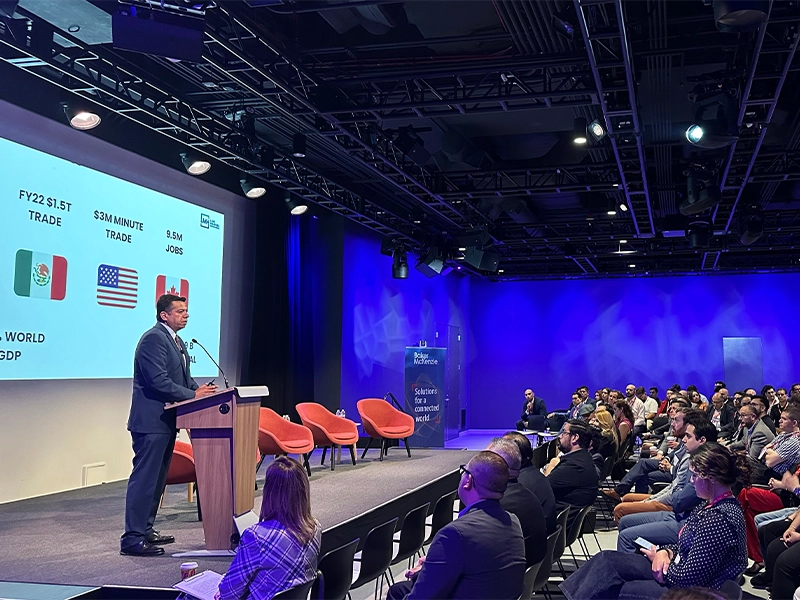Luis Manuel Hernandez’s Insights on Nearshoring: Exploring the Global Economic Outlook and Emerging Opportunities
Luis Manuel holds a Ph.D. in Business from the Atlantic International University in the United States. He was the former President (2016-2020) of Index Zona Costa BC, the Association supporting the development of the Manufacturing, Export, and Maquiladora (IMMEX) sector of Baja California. Currently, he is the President of Index Nacional (at a national level). Additionally, he is a Board Member for Grupo Financiero Banorte.

The Imperative of Being Where Decisions Are Made
Luis Manuel discovered a significant challenge when it came to making influential decisions. Being from Mexico, he often found that his opinions were disregarded. As a result, he made the strategic decision to establish an office in Washington. He noted, “In Washington, we are seen as foreigners, and there is often a lack of understanding regarding manufacturing companies and transfer pricing, which is a matter of great concern.” Addressing the exchange of information between the federal governments of the United States and Mexico is of paramount importance. Sometimes, there is a need for more comprehension of supply chain complexities, even among Mexican governors, US counterparts, and their Canadian counterparts. For this, the USMCA, as a federal-level agreement, requires the involvement of state governors.
As Luis Manuel aptly put it, “If a mayor or governor doesn’t grasp the essence of the supply chain, we face a significant challenge.”
Tijuana’s Role in the Manufacturing Industry
Tijuana stands at the forefront of Mexico’s manufacturing industry, with the highest number of registered manufacturing companies and over six decades of experience in the field. Its strategic location near San Diego makes it a highly attractive destination for international businesses looking to expand operations.
The Future Prospects for Tijuana
The Tijuana-San Diego Binational region is incredibly important. The trade value generated at the US-Mexico border produces a remarkable $815 billion in manufacturing output, which is more than the combined economies of ten US states and Mexico. The region has 58,000 companies along the border, which can be a great resource for its development.
Luis Manuel’s Recommendation:
“Let us direct our focus toward our existing strengths and explore ways to enhance the potential of our binational Mega Region. When governmental bodies fall short in understanding the issues, the responsibility falls upon us to identify the right channels and convey the pertinent message.”
It’s essential to note that the workforce of experts in the United States, Canada, and Mexico is growing old. Therefore, it’s crucial to empower the next generation with the skills they need to navigate the upcoming technological revolution. If we fail to prepare adequately, automation could outpace our understanding leading to regulatory difficulties. The opportunities are abundant, but it’s essential to know where to look for them. Index offers certification programs from prestigious institutions such as Harvard and MIT. These programs can be accessed through online courses available in Spanish, making them a significant resource for preparing for future trade dynamics. Mexico must take proactive steps to consider aftermarket strategies and harness the potential of the next generation.
The USMCA and its Benefits
The USMCA has been in effect for some time now, and according to the Ministry of Economy, the investment figures show that the United States is the largest investor among the three countries.

United States (US$30 billion) & Canada (US$875 million). By sector, investments are concentrated in manufacturing (US$29 billion), followed by transportation (US$15 billion), commerce (US$1.9 billion) and mining (US$433 million).
However, the trade relationships among the United States, Mexico, and Canada have remained stagnant over the years, which has led to difficulties in adapting to changes in the market. To get better prices in such an environment, securing patents is crucial. This is an area where Asia and India have a stronghold, with the U.S. only ranking in the top 20 for patents, and Canada and Mexico lagging in the bottom 50.
Within the framework of the USMCA, three key aspects require attention.
- Firstly, supply chain resilience needs strengthening through effective strategies.
- Secondly, there is a significant gap between the 50 critical industries in the U.S. and the 12 present in Mexico, making it necessary to focus on critical industries.
- Finally, Mexico needs to decrease its dependence on China and enhance competitiveness, particularly concerning labor and minimum wage issues.
During a trilateral meeting in January, the USMCA‘s impact on the middle class was a central point of discussion. The citizens’ primary concern is how these potential changes would affect their lives and livelihoods. The focus remains on creating jobs and stable supply chains for the people.
To conclude
Several topics are of great significance when discussing the binational Mega Region, such as technology, talent, supply chain management, smart manufacturing, and sustainability.
The success of nearshoring depends on a deep understanding of how to implement smart manufacturing and the recruitment of proficient managers, finance directors, and operations directors with a comprehensive understanding of trade dynamics.
As Luis Manuel rightly stated, Mexico already possesses crucial elements for success, and Tijuana EDC plays a key role in safeguarding these investments. Protecting these investments and nurturing human resources is a testament to promoting economic growth and prosperity.





